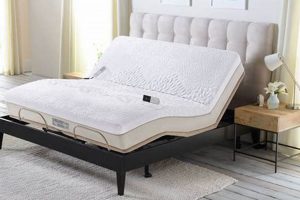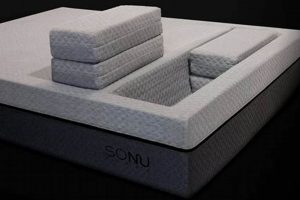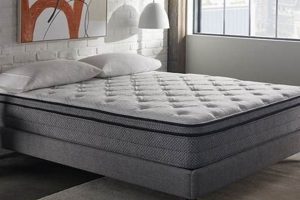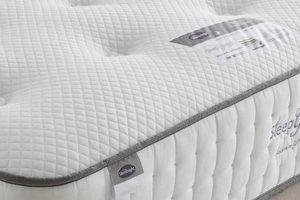Physical discomfort and compromised sleep quality can arise from inadequate support during rest. These issues manifest in various ways, including persistent back pain, stiffness, and restless sleep patterns, ultimately impacting daytime functionality and well-being.
The quality of rest significantly influences overall health. A supportive sleep environment contributes to proper spinal alignment and muscle relaxation, fostering restorative sleep. Conversely, inadequate support can exacerbate pre-existing conditions and hinder the body’s natural recovery processes, leading to chronic discomfort and reduced productivity. Historically, advancements in sleep technology have focused on optimizing support and comfort to mitigate these negative effects.
The following sections will explore the specific indicators of inadequate sleep support and provide guidance on selecting a sleep surface that promotes optimal rest and physical health.
Addressing Discomfort Associated with Suboptimal Sleep Surfaces
Recognizing and addressing the discomfort arising from inadequate sleep support is crucial for maintaining physical well-being and ensuring restorative rest. The following are recommended considerations:
Tip 1: Evaluate Sleep Quality. Monitor sleep patterns and note any disturbances, such as frequent waking, tossing and turning, or difficulty falling asleep. These disruptions may indicate a lack of proper support.
Tip 2: Assess Physical Discomfort. Pay attention to any aches, pains, or stiffness experienced upon waking. Back pain, neck stiffness, and hip discomfort are common indicators of inadequate support.
Tip 3: Review the Mattress Age. Most mattresses have a lifespan of approximately seven to ten years. If the sleep surface is older, it may be losing its ability to provide adequate support and should be considered for replacement.
Tip 4: Consider Sleeping Position. Different sleeping positions require varying levels of support. Side sleepers, for example, often benefit from a softer surface that contours to the body, while back sleepers generally require firmer support.
Tip 5: Consult a Healthcare Professional. If discomfort persists despite adjustments to sleep habits and environment, seek advice from a physician or physical therapist to rule out underlying medical conditions.
Tip 6: Explore Mattress Options. Research different mattress types, such as memory foam, innerspring, and hybrid models, to determine which best suits individual needs and preferences. Consider visiting a retailer to test different options in person.
Tip 7: Examine for Visible Wear. Inspect the sleep surface for sagging, lumps, or unevenness. These physical signs indicate compromised structural integrity and diminished support capabilities.
Addressing indicators of poor sleep support leads to improvements in sleep quality, reduction in physical discomfort, and enhanced overall well-being. Identifying and rectifying these issues is an investment in long-term health.
The following sections will delve into selecting appropriate sleep surfaces and further strategies for optimizing the sleep environment.
1. Back and neck pain
Back and neck pain, as a consequence of inadequate sleep support, represents a significant health concern. These discomforts often stem from compromised spinal alignment and inadequate muscle relaxation during sleep, directly attributable to sleeping on a suboptimal mattress.
- Spinal Misalignment
A mattress that lacks sufficient support can lead to spinal misalignment. The spine, ideally straight when viewed from the back and exhibiting natural curves from the side, is forced into unnatural positions. This misalignment stresses muscles, ligaments, and intervertebral discs, resulting in pain. For example, a sagging mattress can cause the lower back to arch excessively, contributing to morning stiffness and pain. The implications extend beyond mere discomfort, potentially accelerating degenerative disc disease and nerve compression.
- Pressure Point Exacerbation
Inadequate cushioning can exacerbate pressure points. Hips, shoulders, and the base of the skull bear a disproportionate amount of weight during sleep. A surface lacking adequate pressure relief causes concentrated stress on these areas, leading to localized pain and discomfort. For instance, a firm, unyielding mattress can compress the shoulder joint, particularly in side sleepers, resulting in shoulder pain and radiating discomfort down the arm. This pressure-induced pain can disrupt sleep and contribute to chronic pain syndromes.
- Muscle Strain and Tension
Compromised support forces muscles to work overtime to maintain stability. During sleep, muscles should ideally relax and recover. However, a mattress that fails to provide adequate support necessitates continuous muscle engagement, leading to strain and tension. Consider a sleeper with a swayback posture exacerbated by a sagging mattress; the lower back muscles remain contracted throughout the night, resulting in morning stiffness, muscle spasms, and chronic lower back pain. This prolonged muscle tension impedes restorative sleep and contributes to fatigue.
- Compromised Circulation
Excessive pressure on bony prominences can compromise circulation. Restricted blood flow to muscles and tissues exacerbates pain and impedes the healing process. For example, a mattress that is too firm can compress blood vessels, particularly in the extremities, causing numbness, tingling, and pain. This circulatory compromise can disrupt sleep and lead to restless leg syndrome, further compounding the negative effects of inadequate sleep support.
These interconnected facets highlight the detrimental impact of inadequate sleep surfaces on spinal health and musculoskeletal function. Addressing these issues by selecting an appropriate mattress that promotes proper spinal alignment, relieves pressure points, supports muscle relaxation, and maintains adequate circulation is critical for mitigating back and neck pain and promoting restful, restorative sleep.
2. Restless, disturbed sleep
A compromised sleep surface directly contributes to restless and disturbed sleep patterns. The absence of adequate support creates an unstable and uncomfortable sleep environment, triggering frequent awakenings and preventing the attainment of deep, restorative sleep stages. A mattress failing to properly contour to the body necessitates constant postural adjustments throughout the night as the sleeper seeks a more comfortable position, thereby fragmenting sleep cycles. For instance, an individual on a sagging mattress may experience frequent awakenings due to pressure buildup on specific areas or the sensation of rolling towards the center, resulting in a disrupted sleep architecture and reduced overall sleep efficiency. The practical significance of this understanding lies in recognizing the direct link between sleep surface quality and sleep continuity.
Further, a poorly designed mattress can exacerbate pre-existing conditions, compounding sleep disturbances. Individuals with back pain or joint issues often find that inadequate support amplifies their discomfort, leading to increased restlessness and a greater propensity for nighttime awakenings. The cyclical nature of this problem is evident: poor sleep worsens physical discomfort, and increased discomfort further disrupts sleep, creating a negative feedback loop. Consider an elderly individual with arthritis who experiences heightened joint pain due to a lack of proper cushioning; this pain leads to frequent awakenings, reducing sleep duration and quality, and subsequently increasing pain sensitivity. Addressing these issues requires a comprehensive approach, considering both the physical properties of the mattress and any underlying health conditions.
In summary, restless and disturbed sleep is a prominent indicator of inadequate mattress support. The continuous adjustments, frequent awakenings, and exacerbation of underlying conditions underscore the crucial role of a quality sleep surface in promoting uninterrupted, restorative sleep. Recognizing this connection enables targeted interventions, such as mattress replacement or the implementation of supportive sleep accessories, to improve sleep quality and overall well-being. The challenges lie in individual variability and subjective comfort preferences, necessitating personalized assessment and selection of sleep solutions.
3. Increased daytime fatigue
Increased daytime fatigue is a significant consequence directly linked to compromised sleep quality stemming from inadequate mattress support. The continuous disruption of sleep cycles prevents the body from entering restorative stages, leading to persistent feelings of exhaustion and diminished cognitive function throughout the day.
- Sleep Fragmentation and Reduced REM Sleep
A mattress failing to provide adequate support often results in fragmented sleep, characterized by frequent awakenings and transitions between sleep stages. This fragmentation reduces the amount of time spent in Rapid Eye Movement (REM) sleep, a critical phase for cognitive restoration and memory consolidation. A reduction in REM sleep is directly associated with impaired concentration, memory deficits, and reduced alertness during waking hours. For instance, an individual with a mattress that causes pressure points may experience micro-arousals throughout the night, preventing them from achieving sustained REM sleep, thus contributing to marked daytime fatigue.
- Compromised Physical Recovery
Adequate sleep is essential for physical recovery, allowing muscles to repair and energy stores to replenish. When a mattress does not provide proper support, muscles remain tense and strained throughout the night, hindering this restorative process. The resulting muscle fatigue contributes to overall feelings of exhaustion and reduced physical performance during the day. Consider an individual experiencing constant back pain due to a lack of spinal support; the persistent muscle tension prevents adequate recovery, leading to increased fatigue and decreased physical stamina.
- Disrupted Hormonal Regulation
Sleep plays a crucial role in regulating hormone production, including cortisol (the stress hormone) and melatonin (the sleep hormone). Chronic sleep deprivation, stemming from a poor sleep environment, can disrupt these hormonal balances. Elevated cortisol levels during the day contribute to increased feelings of stress and fatigue, while reduced melatonin levels exacerbate sleep disturbances, perpetuating the cycle of fatigue. For example, prolonged exposure to an uncomfortable mattress can trigger a chronic stress response, leading to elevated cortisol levels that interfere with sleep and contribute to daytime fatigue.
- Reduced Cognitive Performance
The cognitive consequences of sleep deprivation are well-documented. Insufficient or fragmented sleep impairs cognitive functions such as attention, decision-making, and problem-solving. Daytime fatigue resulting from poor sleep quality directly translates to reduced cognitive performance, affecting productivity, work performance, and overall cognitive well-being. An individual experiencing persistent sleep disturbances due to an unsupportive mattress may struggle to focus at work, make sound decisions, and maintain optimal cognitive function, leading to reduced job satisfaction and increased risk of errors.
These interconnected factors illustrate the significant impact of inadequate mattress support on daytime fatigue. The disruption of sleep cycles, compromised physical recovery, disrupted hormonal regulation, and reduced cognitive performance collectively contribute to a diminished quality of life. Addressing these issues through the selection of a supportive and comfortable mattress is essential for promoting restorative sleep and mitigating the debilitating effects of daytime fatigue.
4. Exacerbated joint stiffness
Inadequate support during sleep can lead to heightened joint stiffness, particularly among individuals with pre-existing conditions such as arthritis or other musculoskeletal disorders. The direct correlation between compromised sleep surfaces and increased joint discomfort is attributed to several key factors.
- Compromised Spinal Alignment
A mattress lacking adequate support often results in spinal misalignment, placing undue stress on joints throughout the body. The unnatural positioning can exacerbate inflammation in already compromised joints, leading to increased stiffness and pain upon waking. For example, a sagging mattress may cause the hips and shoulders to rotate unnaturally, stressing the spinal joints and contributing to morning stiffness. The long-term implications of this misalignment can include accelerated joint degeneration and chronic pain.
- Reduced Circulation and Tissue Oxygenation
Poor sleep posture and increased pressure on bony prominences can impede circulation to the joints and surrounding tissues. Reduced blood flow impairs the delivery of oxygen and nutrients necessary for joint health, potentially leading to increased inflammation and stiffness. A mattress that is too firm may compress blood vessels, particularly in the extremities, resulting in reduced circulation to the joints of the hands, feet, and knees, thereby exacerbating stiffness. This circulatory compromise hinders the natural healing processes that occur during sleep.
- Prolonged Static Loading
When a mattress fails to distribute weight evenly, certain joints bear a disproportionate load for extended periods during sleep. This prolonged static loading can lead to increased pressure on the joint cartilage, promoting inflammation and stiffness. Individuals who sleep on their side on a mattress without sufficient contouring often experience exacerbated hip and shoulder stiffness due to the sustained pressure on these joints. The consequences of prolonged static loading include cartilage damage and accelerated joint degeneration.
- Inadequate Muscle Relaxation
Muscles surrounding the joints play a crucial role in providing support and stability. Inadequate sleep support can prevent these muscles from fully relaxing during sleep, leading to increased tension and stiffness. The persistent muscle tension can restrict joint movement and exacerbate pain. For instance, a mattress that does not adequately support the neck can cause the surrounding neck muscles to remain tense throughout the night, resulting in neck stiffness and limited range of motion upon waking. This lack of muscle relaxation impedes joint lubrication and contributes to the overall sensation of stiffness.
The interplay of compromised spinal alignment, reduced circulation, prolonged static loading, and inadequate muscle relaxation highlights the detrimental impact of unsuitable mattresses on joint health. Choosing a sleep surface that promotes proper spinal alignment, facilitates adequate circulation, evenly distributes weight, and allows for complete muscle relaxation is essential for mitigating joint stiffness and promoting restorative sleep. A thorough understanding of these factors enables informed decision-making when selecting a mattress to optimize joint health and overall well-being.
5. Poor sleep quality
Poor sleep quality is a cardinal manifestation of an inadequate sleep surface, directly influencing various aspects of physical and cognitive well-being. The compromised support and discomfort stemming from an unsuitable mattress directly impede the attainment of restorative sleep stages, resulting in fragmented sleep patterns and diminished overall sleep efficiency. A mattress failing to provide adequate spinal alignment or pressure relief can trigger frequent awakenings and restlessness, thereby preventing the body from entering deep sleep, which is essential for physical repair and hormonal regulation. For instance, individuals experiencing persistent back pain due to a sagging mattress often report difficulties falling asleep, frequent nighttime awakenings, and an overall reduction in perceived sleep quality. This disrupted sleep architecture has cascading effects on daytime functionality, contributing to fatigue, impaired concentration, and reduced cognitive performance.
The connection between poor sleep quality and an inadequate sleep surface extends beyond mere discomfort; it triggers a cascade of physiological responses. Chronic sleep deprivation, resulting from consistently poor sleep quality, can disrupt the hypothalamic-pituitary-adrenal (HPA) axis, leading to elevated cortisol levels and increased stress. Furthermore, inadequate sleep impacts glucose metabolism, potentially increasing the risk of insulin resistance and weight gain. Consider individuals with pre-existing sleep disorders, such as insomnia or sleep apnea, who find that their symptoms are significantly exacerbated by an unsupportive mattress; the lack of proper spinal alignment and pressure relief can worsen breathing difficulties and increase the frequency of arousals, further compromising sleep quality. Addressing the root cause, namely the inadequate sleep surface, is crucial for mitigating these negative physiological consequences.
In conclusion, poor sleep quality is a primary indicator of an unsuitable sleep environment, directly attributable to inadequate mattress support. The resultant sleep fragmentation, disruption of physiological processes, and exacerbation of pre-existing conditions underscore the importance of selecting a mattress that promotes proper spinal alignment, pressure relief, and overall sleep comfort. Identifying and addressing the factors contributing to poor sleep quality, particularly those related to the sleep surface, represents a critical step in optimizing sleep health and overall well-being. The challenges lie in the subjective nature of comfort preferences and the need for individualized assessment to determine the most appropriate sleep solution.
Frequently Asked Questions About Sleeping on a Bad Mattress Symptoms
The following addresses common inquiries concerning the adverse effects of inadequate sleep surfaces on physical health and sleep quality.
Question 1: Can a mattress truly be the primary cause of back pain?
Yes, a non-supportive mattress is a frequent contributor to back pain. Inadequate spinal alignment and pressure point exacerbation disrupt normal musculoskeletal function, leading to discomfort.
Question 2: How does one differentiate between normal fatigue and mattress-induced fatigue?
Mattress-induced fatigue often manifests as persistent exhaustion despite adequate sleep duration. It is commonly accompanied by morning stiffness and musculoskeletal discomfort. If fatigue persists and coincides with these symptoms, the sleep surface should be evaluated.
Question 3: Is there a specific mattress type recommended for individuals experiencing these symptoms?
No single mattress type universally resolves these symptoms. The optimal choice depends on individual sleep preferences, body weight, and pre-existing conditions. Memory foam, latex, and hybrid mattresses are frequently recommended for their ability to provide both support and pressure relief. Consulting with a sleep specialist may be beneficial.
Question 4: How often should a mattress be replaced to avoid these issues?
Mattresses typically have a lifespan of seven to ten years. However, visible signs of wear, such as sagging or unevenness, or a noticeable increase in discomfort, warrant earlier replacement.
Question 5: Are there any supplementary measures to alleviate symptoms while awaiting mattress replacement?
Yes. Supportive pillows, proper sleep posture, and a consistent sleep schedule can mitigate symptoms. Over-the-counter pain relievers and gentle stretching exercises may also provide temporary relief.
Question 6: Can sleeping on a bad mattress contribute to long-term health problems?
Prolonged exposure to an inadequate sleep surface can contribute to chronic pain, sleep disorders, and reduced overall quality of life. Addressing these issues promptly is crucial for preventing long-term health complications.
Recognizing the impact of the sleep environment on physical well-being is paramount. Addressing issues related to the sleep surface can lead to significant improvements in sleep quality and overall health.
The following sections will provide additional strategies for optimizing the sleep environment.
Consequences of Inadequate Sleep Support
This exploration of “sleeping on a bad mattress symptoms” has illuminated the multifaceted impact of an unsuitable sleep surface. Persistent back and neck pain, restless sleep, daytime fatigue, exacerbated joint stiffness, and overall poor sleep quality represent significant indicators of compromised support. These symptoms extend beyond mere discomfort, potentially leading to chronic health issues and diminished quality of life.
The recognition and timely remediation of these symptoms are crucial for maintaining long-term physical and cognitive well-being. Prioritizing a supportive and comfortable sleep environment is a fundamental investment in overall health, warranting careful consideration of mattress selection and sleep hygiene practices.







